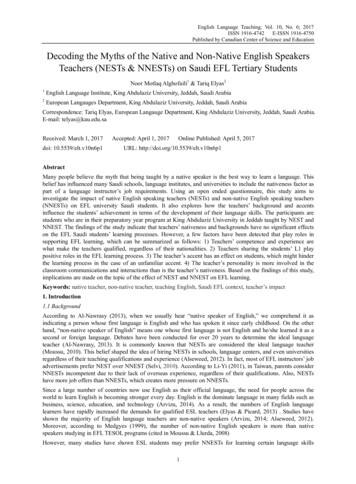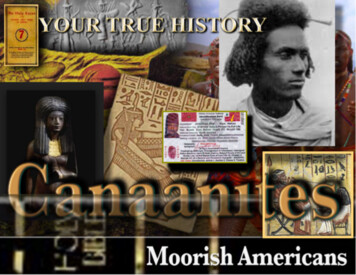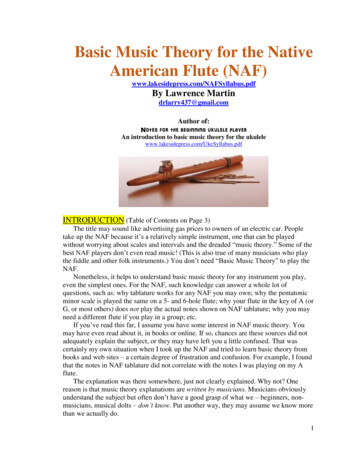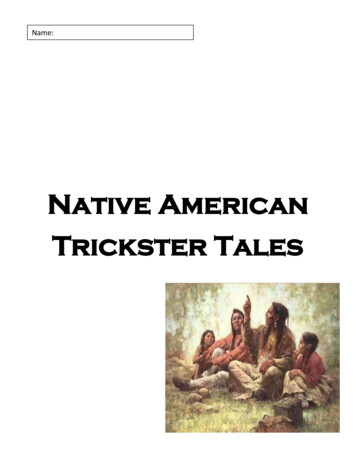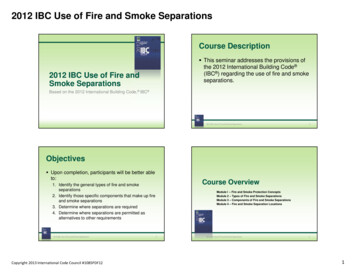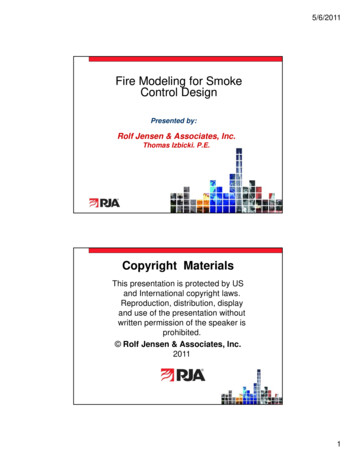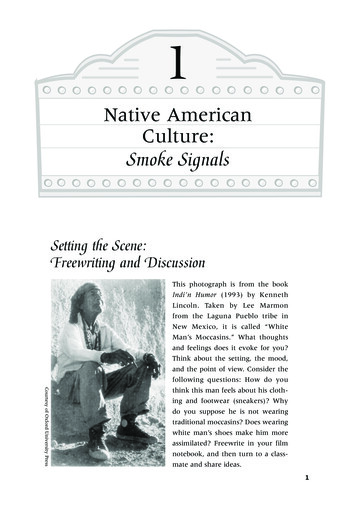
Transcription
1Native AmericanCulture:Smoke SignalsSetting the Scene:Freewriting and DiscussionCourtesy of Oxford University PressThis photograph is from the bookIndi’n Humor (1993) by KennethLincoln. Taken by Lee Marmonfrom the Laguna Pueblo tribe inNew Mexico, it is called “WhiteMan’s Moccasins.” What thoughtsand feelings does it evoke for you?Think about the setting, the mood,and the point of view. Consider thefollowing questions: How do youthink this man feels about his clothing and footwear (sneakers)? Whydo you suppose he is not wearingtraditional moccasins? Does wearingwhite man’s shoes make him moreassimilated? Freewrite in your filmnotebook, and then turn to a classmate and share ideas.1
2 Seeing the Big PictureSneak PreviewAbout the FilmSmoke Signals (1998) is a film about Indians,1 but it may not be whatyou expect, especially since the title suggests that it could be justanother standard Western so popular in cinematic history. If you’veseen even a few of the more than 2,000 Westerns made since the early1900s, you know that Indians are usually depicted in stereotypicalfashion—as bloodthirsty renegades, stoic warriors, noble savages, orbuckskin-clad princesses. Except for historical figures such as Geronimoand Cochise, Indians in western films rarely have names or individualpersonalities; they speak neither English nor any other language(though they do grunt and whoop), and they spend a lot of timeambushing whites. In the typical cowboy-and-Indian scenario, handsome, rugged heroes like John Wayne play the parts of men chargedwith bringing civilization to the Wild West and protecting women andchildren settlers from the warriors’ arrows and tomahawks.But Smoke Signals is not about warriors, nor is it set on the 19thcentury Western frontier. It distinguishes itself as a full-length featurefilm written, directed, coproduced, and acted (in all major roles) byNative Americans. Based loosely on Sherman Alexie’s short novelentitled The Lone Ranger and Tonto Fistfight in Heaven (1994), it won twoawards at the Sundance Film Festival. By all measures it is a landmarkfilm that, in Alexie’s words, “challenges the cinematic history ofIndians” (Summa 1998). It does so by bringing new Indian charactersto the screen who, as Alexie says, are not the silent, stoic types we’reused to, nor are they depressed victims. In real life, Alexie tells us,“Indians are the most joyous people in the world” (D4).In fact, notice when you watch the film how humor plays a centralrole. As early as 1969, Native legal scholar Vine Deloria, Jr., tried tocorrect misconceptions about stone-faced Indians in his book CusterDied for Your Sins (1969). He begins his chapter on “Indian Humor” bystating that “One of the best ways to understand a people is to knowwhat makes them laugh” (148). Not only is the popular image ofIndians all wrong, he says, but even experts on Indian affairs havefailed to mention how humor pervades Indian life.1. As is often common practice, we use Indians and Native Americans interchangeably. SeeTerms to Know for further explanation.
Native American CultureIn his fascinating Indi’n Humor, author Kenneth Lincoln says thatIndians respond to life with “sharp humor, a good dose of sarcasm,resigned laughter, and a flurry of ironic ‘rez’ (reservation) jokes” (5).For many Native people, humor is a way of enjoying life and also ameans of psychological survival. Lincoln provides a quote from John(Fire) Lame Deer of the Lakota Sioux to help clarify what Indianhumor is about: “For a people who are as poor as us, who have losteverything, who had to endure so much death and sadness, laughteris a precious gift . . . We Indians like to laugh” (58).When you watch the film, you’ll see how real, ordinary people living in the present time go about their daily lives with humor and dignity. As you get to know the characters, you may wonder why it tookso long for this unromanticized, demythologized presentation ofIndians to come to the big screen. The main reason is that featurefilms are expensive to make and thus have been produced, directed,and written by those with sufficient means to do so—which has usually meant white men. For more than a century, directors like JohnFord (of Irish-American descent) were the ones making decisionsabout how to present Indians to primarily white audiences.Furthermore, because authenticity has been less important thandrawing big crowds to movie theaters, the more important, moreglamorous Indian roles of the past have commonly been played byheavily made-up non–Native American actors familiar to the moviegoing public. Rock Hudson, Elvis Presley, Raquel Welch, and AudreyHepburn are a few of the Hollywood stars who have been cast asIndians. You can imagine that from an Indian p.o.v., it can be insulting (not to mention rather ridiculous) to see made-up white actorsplaying major Indian roles.This is not to say that enlightened filmmakers never deviated fromthe old patterns prior to Smoke Signals. A few early movies are sympathetic to Indians, such as Broken Arrow (1950) and Little Big Man (1970);in addition, the more recent Dances with Wolves (1990) and House Made ofDawn (1987) break new ground (as do the movies recommended at theend of the chapter). But the p.o.v. of Indians themselves has been foundalmost exclusively in documentaries. Created by a large number ofactive, dedicated Indian filmmakers such as Alanis Obomsawin (of theAbenaki tribe) and Victor Masayesva (of the Hopi tribe), these splendid,usually low-budget works are evidence of a richness that as yet has notreached a wide audience. Since it can be difficult to find the documentaries, you might keep an eye out for Native American film festivals. 3
4 Seeing the Big PictureCheck the website at www.imaginenative.org to see what kinds of excitingthings are going on.About the Filmmakers and Actors of Smoke SignalsOne of six siblings, Sherman Alexie (born 1966) grew up in povertyon the Spokane Indian Reservation in Wellpinit, Washington. Hismother is part Spokane, and his father is full-blooded Coeur d’Alene.Both of his parents were alcoholics, but his mother was able to breakher addiction when her son was seven years old, and she subsequently became a tribal drug and alcohol abuse counselor.A frail and sickly child, Alexie realized early that humor was aneffective way to stave off bullies.People like to laugh, and when you make them laugh, they listen to you. That’s how I get people to listen to me now. . . . I’msaying things people don’t like for me to say. I’m saying veryaggressive, controversial things, I suppose, about race and gender and sexuality. I’m way left [in my viewpoints], but if yousay it funny, people listen. If you don’t make ’em laugh, they’llwalk away. (Blewster 1999, 26–27)Alexie also avoided being picked on by spending a lot of time inthe reservation school library. He later attended junior high and highschool off the reservation in the nearby predominately white town ofReardon, where, he recalls with humor, he and the school mascotwere the only Indians. Successful as a high school basketball player,honor society member, class president, and debater, he received ascholarship to Gonzaga University in Spokane.After two years at Gonzaga, where he struggled with a drinkingproblem, he discontinued his studies, finishing later at WashingtonState University in Pullman. He credits Alex Kuo, his professor in apoetry class, with helping him discover his talent as a writer. Severalpoems written for Kuo’s class were published in his first book, TheBusiness of Fancydancing (1991). While still living in Pullman, Alexie,now sober, became a popular figure at local poetry readings.Since 1991, Alexie’s literary career has been remarkable. Thoughhe considers himself primarily a poet and has published more thanten volumes of poetry, his widespread popularity has come from hisfiction and screenplays. His frequent readings and literary presenta-
Native American Culturetions are well attended and hugely successful. Quick-witted and a natural comic, he does not simply read from his works but engages theaudience in a freewheeling style that keeps people captivated andlaughing throughout. He has a large and loyal following amongIndians and non-Indians alike.You can find interesting information about Alexie, including hisschedule of upcoming presentations, on his website http://fallsapart.com.Don’t miss the opportunity to hear him speak.Director Chris Eyre (born 1969) is of Cheyenne/Arapaho descent.He was adopted by a white family and grew up in Klamath Falls,Oregon, later attending school in Portland. Since receiving his master’s degree in filmmaking at New York University, he has directed animpressive number of films. You might visit his website www.chriseyre.org.The cast of experienced and accomplished Native American actorsincludes Gary Farmer, who won a loyal following for his role as PhilbertBono in Powwow Highway (1989); Tantoo Cardinal, who has playeddozens of fine roles, including that of Black Shawl in Dances with Wolves(1990); Adam Beach, who speaks to native youth throughout theUnited States and Canada; Evan Adams, who plays the lead role inSherman Alexie’s directorial debut, The Business of Fancydancing (2002),and who is an obstetrician in Vancouver, British Columbia; IreneBedard, who was the physical model for, and the voice of, the Disneycharacter Pocahontas; and John Trudell (www.johntrudell.com), who is apoet, musician, and political activist known especially for his leadershipof AIM (American Indian Movement) and his participation in thetakeover of Alcatraz Island (see pages 15–16). For further informationon the actors, check www.imdb.com.Who’s Who in the FilmVictor Joseph (Adam Beach)—young man abandoned by his fatherThomas Builds-the-Fire (Evan Adams)—Victor’s storyteller companionArnold Joseph (Gary Farmer)—Victor’s father who leaves for PhoenixArlene Joseph (Tantoo Cardinal)—Victor’s motherGrandma Builds-the-Fire (Monique Mojica)—relative who raises ThomasRandy Peone (John Trudell)—K-Rez announcerSuzy Song (Irene Bedard)—woman who befriends Arnold Joseph in PhoenixDirector—Chris EyreScreenwriter—Sherman Alexie 5
6 Seeing the Big PictureTen Indian Culture Areas in North AmericaTerms to Knowaboriginal peoples—Used primarily to refer to the original inhabitants of Australia, but sometimes also used in reference to otherNative peoples.Alaska Natives—Used to refer to the indigenous peoples ofAlaska, such as Aleuts and Inuits (Eskimos).American Indian—Similar to Indian; often used in everydayspeech and in legal documents.
Native American CultureFirst Nations—Used in Canada to refer to sovereign Native people.Native Canadian and Native people are also used in Canada.Hawaiian Natives, Native Hawaiians, Hawaiians—Indigenouspeople of Hawaii.Indian—Widely used to refer to the many different indigenouspeoples who inhabited this country before the European conquestand to their descendants. The word itself is attributed to ChristopherColumbus, who, falsely believing he had landed in India, used theSpanish word indios to refer to the people he encountered. Indian isnot used with relation to the original inhabitants of Alaska or Hawaii.indigenous people—Often used by anthropologists and others to referto groups native to a region; avoids the word native, which sometimes has pejorative associations with the idea of being primitive.nation—Similar to tribe and suggesting political independence. (Inthe legal terms of the dominant white society, not all tribes areactually nations.)Native American—First came into widespread use in the 1960s in theBureau of Indian Affairs. Devised as a respectful way of referring toIndians, it is used more by others than by Indians themselves.Native people—Has gained international acceptance as a way ofreferring to indigenous people.powwow—Probably derived from an Algonquian word for a healer orspiritual leader who could see the future in dreams. The term iscommonly used to refer to a talk or meeting (“Let’s powwow . . .”),but to Native Americans, powwows are opportunities to express andcelebrate their heritage. Often open to the public, powwows areoccasions for socializing, singing, dancing, and feasting.red man—Reference to the skin color of Native Americans, which isnot really red. Though generally considered dated and offensive,the term is sometimes used neutrally in phrases like, I don’t care ifhis skin is black, white, red, or purple. Red Power was a slogan usedby Indian activists during the Civil Rights Movement.redskin, squaw, injun—Highly derogatory terms.res or rez—Short for reservation; may seem disrespectful if used bynon-Indians.reservation—Fixed areas of land in the western part of the UnitedStates where Indians were forced to settle and reside beginning inthe mid-1800s.tribe—Group of Indians sharing a common heritage. 7
8 Seeing the Big PictureHistory FlashbackVictor, Thomas, and most of the other Indians we meet in SmokeSignals are living on the Coeur d’Alene Reservation in WashingtonState, one of approximately 300 reservations in 29 states. According to the 2000 U.S. Census, about 538,000 Indians, or one-fifth ofthe total Indian population, are living on reservations. Refer tothe map.How did reservations come about? Who created them, and whenand why did they come into existence? What are they like, and whatdo they offer to modern-day Native Americans?American Indian Reservations
Native American CultureIndians as Original InhabitantsTo answer these questions, let’s flash back more than 500 years to thetime of Columbus’s landing in the New World in 1492, when Indianswere the sole inhabitants of the hemisphere. At that time hundreds oftribes occupied a vast stretch of territory equivalent to one-fourth of theearth’s habitable land, extending from northern Alaska to Cape Horn.There is no way to know the size of the population at the time ofColumbus; among scholars much controversy surr
fashion—as bloodthirsty renegades, stoic warriors, noble savages, or buckskin-clad princesses. Except for historical figures such as Geronimo and Cochise, Indians in western films rarely have names or individual personalities; they speak neither English nor any other language (though they do grunt and whoop), and they spend a lot of time ambushing whites. In the typical cowboy-and-Indian .
